Kaitlin Gili
Home Institution: Stevens Institute of Technology
Status: Sophomore, Expected Graduation Date: May 2020
Field of Study: Physics with a Minor in Computer Science
Host Lab in Japan: Keio University – Dept. of Applied Physics & Physico-Informatics, Itoh Laboratory
Host Professor: Prof. Kohei Itoh
Research Project Title: Comparing Classical and Quantum Finite Automata (PDF)
Why Nakatani RIES?
I decided to apply to the Nakatani RIES Fellowship because I want to be put in uncomfortable situations that are going to allow me to grow as a person. Over the past few years at my university, I’ve found that I learn the most when I’m faced with a challenge or put into an environment that is foreign to me. This program is the ultimate opportunity for both academic and cultural enrichment. It will allow me to pursue my passion in physics research, as well as provide me with a new perspective and appreciation for a culture that I have yet to explore.
This program is an experience of a lifetime. It offers the opportunity for me to learn a language that is extremely unlike my own and connect with people that are both similar and different from me. I believe that we have something in common with everyone that we meet, and I am excited to connect with people that have grown up on the opposite side of the globe.
Goals for the Summer
- To gain more experience and knowledge in my research field
- To learn from my research mentors and establish lasting relationships with those in the program and in my host lab
- To connect with Japanese locals and other travelers from around the world using primarily Japanese language
- To be adventurous with food, visit places of worship, and participate in Japanese fitness/martial arts classes
Meaning of Nakatani RIES – Post Program
Five months ago I was offered I think one of the best experiences of my life. I remember getting the email early on a Friday morning and I started screaming in my apartment. I remember calling my mom and telling her that I am going to be spending three months in Japan for the summer doing physics research. We both screamed. After having this experience, I feel incredibly lucky to have been chosen as one of the 12 U.S. students selected for the 2018 program. I honestly believe that we are the 12 luckiest college students in the world right now. This program meant so much to me from being able to conduct research with extraordinary mentors to getting to experience Japanese culture. All in all, my experience this summer was incredible and I know now that I was offered one, if not the best, experience of my life.
My favorite experience in Japan was … climbing mount Fuji at the end. This was a once in a lifetime experience and I’m glad that I got to share it with the other Nakatani fellows.
Before I left for Japan I wish I had … studied more Japanese phrases and researched what I wanted to do there. This would have been really helpful.
While I was in Japan I wish I had … visited Hiroshima. Because there was flooding this summer, I didn’t have the weekend to travel there and I would have like to have gone.
Overview of Research Experience in Japan
My research this summer was easily the best academic experience that I’ve had so far. Last summer, I did experimental research and found that it wasn’t as thrilling or exciting as I thought it would be. However, this summer changed my mind about research completely and opened a new door for the type of research that I want to do. This summer, I worked at Keio Diagaku in the Itoh Lab group with the IBM Q hub on software for quantum computers. Before this summer, I had no idea what quantum computing was. I had no idea that large companies such as Google and IBM were competing for this kind of technology and software. Once I started learning about it, I found it absolutely fascinating and I fell in love with the subject. Now I know that I want to pursue a PhD in Quantum Computing and go into industry rather than academia. I developed so many amazing skills and found a passion that I had never explored.
While everyone’s lab dynamic in Japan was very different, I had an extremely positive experience from mine. Everyone in my lab was very friendly and welcoming. I think it also helped that many of them had studied abroad in America, so they spoke English very well. It was very easy to connect with them. We ate lunch together everyday and most often, we’d eat dinner together. We even went out on lab trips around Tokyo and Nagano. We went peach picking, to an onsen, to Tokyo SkyTree, and even just wondered around Tokyo city. I had a blast with them and I plan on keeping in touch and seeing them again someday.
Daily Life in Japan
I really enjoyed my daily life in Japan. I would get up early, go to lab and get a coffee, work with my lab mates and listen to IBM Q seminars, eat lunch with my lab, work more, and then go home and cook dinner or go explore Tokyo. On the weekends, I traveled everywhere. I never took one weekend to rest, which I am proud of because I really did want to focus on traveling this summer as well as research. I love all of the food that I got to try in Japan such as Japanese curry and Okonomiaki. It was all so delicious. I also made really close friends out side of my lab that attend Keio and we would go to dinner and hang out a lot. I’m going to miss them the most.
Another amazing thing that I got to do in Japan was join a kickboxing gym. This experience was incredible and connected me to Japanese culture in a different way. I was the only non-Japanese person at the gym and almost no one spoke English. This was an interesting adjustment, but it made me realize that language doesn’t have to be a barrier for connection. I still made friends in my gym and laughed with them despite the language barrier. Laugher and fun is universal. I also visited many temples and shrines in Japan that allowed me to better understand Japanese culture. I think by traveling and making new friends in Japan, I learned a lot about their culture and myself.
Excerpts from Kaitlin’s Weekly Reports
- Week 01: Arrival in Japan
- Week 02: Language Learning & Trip to Mt. Fuji Lakes
- Week 03: Noticing Similarities, Noticing Differences
- Week 04: First Week at Research Lab
- Week 05: Cultural Analysis – Life in Japan
- Week 06: Cultural Experience – In the Lab & Preparation for Mid-Program Meeting
- Week 07-08: Overview of Mid-Program Meeting & Research Host Lab Visit
- Week 09: Research in Japan vs. Research in the U.S.
- Week 10: Reflections on Japanese Language Learning
- Week 11: Interview with a Japanese Researcher
- Week 12 & 13: Final Week in Japan & Re-Entry Program
- Final Research Project Overview and Poster
- Follow-on Project
- Tips for Future Participants
Week 01: Arrival in Japan
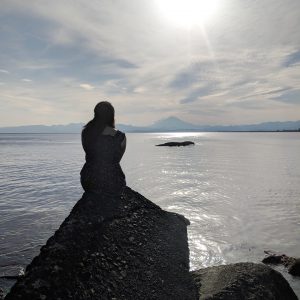
This experience has been incredible thus far, and I know that there are even more exciting adventure to come, but it is nice to reflect back on what it was like before I arrived in Japan. I really enjoyed the pre-departure meeting in Houston at Rice University simply because it helped me get connected to the other eleven students that I would be spending a lot of time with in Japan and it allowed me to have a few days to emotionally prepare myself before entering a new part of the world. The icebreakers and food events were a really fun way to bring everyone together, and I do think that we all became friends before we arrived in Japan. I also think that all of the last minute packing advice was helpful so that I could easily go to CVS the night before we left to buy some extra gifts for my professors and lab mates.
Toky-Woah! That really sums up how I feel about Tokyo, Japan and just my experience living here this past week. First off, the city is just so beautiful and clean, especially in the area of the Sanuki Club. I have really enjoyed exploring the different areas such as Shibuya, and trying all of the different foods that this place has to offer. So far, I have found this one bakery that I think has some of the most amazing bread and pastries that I have ever tasted. I also tried Japanese curry for the first time! I think the most challenging part of being here though is not being able to eat/drink as I walk. I mentioned this in my American Values section, but it is honestly so hard for me that it deserves to be brought up again. I really enjoy walking with ice cream, or walking with a coffee. It’s going to be very hard for me for the rest of the summer to adjust to this part of the culture.
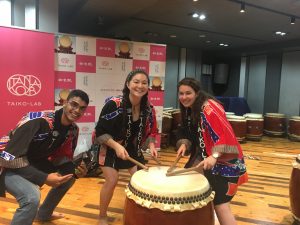
Japanese language classes are a lot of fun, but very difficult for me. I am someone who needs time to sit down and memorize vocabulary and grammar, and the classes move way too fast for me to get through all of it. Therefore, each class, I feel like I only know half of the information from the last class. Plus, sometimes, our language teachers cannot translate sentences very well from Japanese to English, so I end up confused and not understanding the actual grammar of the phrase; instead I just have to memorize it. I do think that I have learned a lot of Japanese in a very short amount of time though. My language skills have improved greatly, and I think with the foundation that I have from the first week; it’s going to make the second week a little easier, hopefully! Also, I am trying to use some of what I learned outside of class, usually when I am at a shop and want to buy something because this is what I know the most vocabulary for. I went to a garage sale yesterday in Kamakura, and I asked Ikura desu ka, and it was fun to see the surprise on the women’s face when I asked in Japanese how much something was. It’s moments like this that I really appreciate the Japanese lessons!
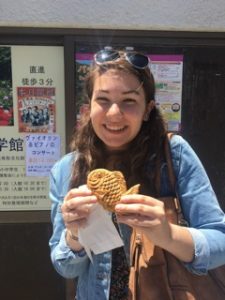
I’m very thankful for the Nakatani Foundation, and those in the program who have planned for all of our activities in Tokyo. This week has been an absolute blast, but I think the activity that stands out the most was Taiko Drumming on Wednesday. This was so much fun, and a good work out for my arms (they were definitely sore the next day). This is a part of the culture that I would have never thought to experience on my own, and I would have missed out if I hadn’t taken a part in it. I also really enjoyed the Saturday day trip to Takasaki to visit the archeological sites. Because I live in America, which is a relatively young nation, I sometimes forget how far back in time historians have gone to replicate ancient civilizations and discover actual artifacts from these times. There is so much history in Japan, and this was an amazing opportunity to learn about it from a professor through the viewing of actual burial sites and tombs.
Research Project Overview
This summer, I will be conducting my research at Keio University in the Itoh Laboratory, under Itoh-Sensei. So far, I have learned that my project is going to be on Quantum Software. I have not been informed of the main aspects of my project; I have only been provided with a brief description. For the first half of the research period, I will learn the basic concept of quantum computing, including both theory and programming skills. In the second half of the research period, I will be developing actual quantum software based on the needs of scientific and industrial communities using a 20-qubit quantum computers provided by IBM.
Week 02: Language Learning and Trip to Mt. Fuji Lakes
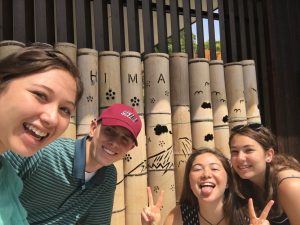
Japanese class has really added to my cultural experience thus far and has helped me with vocabulary/grammar constructs when communicating with other people here. Before coming to Japan, I knew zero Japanese. Now, I definitely feel like I know a lot of vocabulary and enough grammar to speak in really simple sentences. I can definitely write in Japanese better than I can speak it. This whole week, we’ve been learning past/conditional tenses, and while it has been interesting, it has also been extremely difficult. I’m not that great at speaking yet. Despite my inability to speak fluently, I’ve definitely used a lot of the vocab in my daily interactions. I use a lot of the vocabulary that I’ve learned at the grocery store and at my kickboxing gym. My kickboxing gym has been the biggest challenge with the language so far. Almost nobody at my gym speaks English, especially my sensei. They only speak Japanese to me and because of Japanese lessons; I can pick up on some of the vocabulary and answer a little bit in Japanese. It’s really nice because they can see that I’m trying to speak their language, and they even try to speak English too. It’s such a cool experience to share language and see how happy they get when I try to speak Japanese to them. My goal for the rest of the summer is just to improve my speaking skills by learning more vocabulary and practicing grammar in my free time. I hope that I can meet a friend in my host lab that will practice with me!
My favorite thing that we did this week was go to the Grand Sumo Tournament. This is something very specific to Japan and it was cool to see in person. I like how a lot of local people as well as tourists go to the tournaments. There were a lot of kids in the stands that were cheering on their favorite sumo wrestler. I didn’t know any famous ones so I just started screaming what they were screaming. I had so much fun! Lincoln and I also got ice cream and pancakes, which was absolutely delicious! Also, I really enjoyed going to JAMESTEC and then Chinatown after for dinner. The dinner was amazing!!! Lincoln and I just stuffed our faces, and Ogawa-san kept telling us to order more dessert! Our whole table got a ton of food and we went home with stomachaches. It was definitely worth it though!!
Mount Fuji Lakes Trip
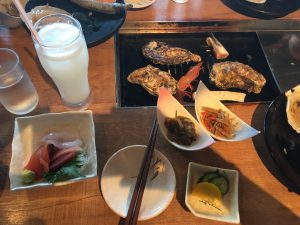
The Mount Fuji Lakes trip was so much fun in many different ways. I really enjoyed it first of all because we got to meet and spend time with the Japanese fellows. A few of the girls and I bonded over our love for Harry Potter and food. Apparently, Harry Potter is a really big deal in Japan, which makes me so happy! It was fun getting to know the Japanese fellows and talk to them about their home and culture. They even taught us how to play a card game that they play often; it was very fun and got pretty competitive. I definitely enjoyed getting to know them and I am looking forward to seeing them again in Kyoto!
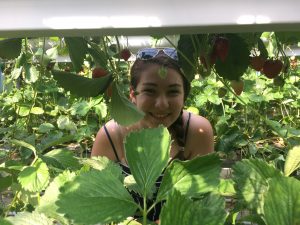
There were definitely many highlights of the Fuji Trip. I really liked the Mishima SkyWalk Bridge that allowed us to get a really nice view of Mount Fuji and the other mountains surrounding it. We took a lot of nice pictures. I also really enjoyed all of the food that we ate. Near our hotel, we went to a huge buffet, where I got to have a variety of foods from different cultures. Plus, it was all you can eat!! Afterwards, we went to a really cool light show at our hotel. Our hotel suites were really interesting. To be honest, it looked like we were staying at a weird Disney Land. Our rooms were little huts that were right next to some amusement park rides. It was a very interesting place, but it felt super cozy. I also really enjoyed the food that we ate on the second day; we went to a seafood place for lunch that allowed us to cook our seafood right in front of us! This was absolutely amazing because I had never done anything like this before. I used to be a super picky eater, and the old me would have never gone for food like that. However, this me, tried all of it and found it all to be absolutely delicious. We also went to the aquarium, which was so fun, and then we ended our trip strawberry picking!! This was my favorite part of the trip! The strawberries were so beautiful and fresh. I definitely found them to be softer and sweeter here than in the US. We dipped them in condensed milk and they were so delicious. All in all, this was a weekend to remember. It included great food, wonderful people, and beautiful scenery! I would do it all over again!
Question of the Week
Why do Japanese women not like to walk around in their athletic clothing and always shower and change at the kickboxing gym before leaving?
- In Japan, you typically wear a specific type of outfit or clothing for specific activities. Then, when done with that activity, you change back into your other clothing. Also, consider how close you have to sit/stand to people on the subway or bus. Showering after working out is also a considerate thing to do for your fellow commuters.
- The Japanese students who come to the U.S. often ask the same question in reverse. Why is everyone wearing gym/yoga clothes all the time? Are they always on their way to work out?
- Gym Clothes: Do’s and Don’ts in Tokyo (Savvy Tokyo)
- See also some of the articles on our Fashion in Japan section on our Life in Japan resources page.
Introduction to Science Seminars
The seminars this week were very interesting! Professor Kono gave a lot of interesting information regarding different physics phenomena and their real life applications. I found it very useful when he started talking about qubits and quantum computation since this is what is my research is going to be related to. I also like that he reviewed a lot of physics topics that I learned in my university classes and he discussed methods for how to find different variables and constants. The other talks were also very interesting! I didn’t know much about carbon nanotubes before the talks, but now I feel as if I understand them a lot more.
For my research internship, I will be studying quantum software and using a qubit computer provided by IBM. I still don’t know too much about my project, but I believe that I will be studying optical and mechanical properties. I’m also unsure of my experimental technique, as I will be spending the first half of the summer learning about quantum software and my second half designing my own software. There are many applications for quantum software, the main one being the development of quantum computers. Quantum computers would be able to solve problems at a faster rate and go through computations that classical computers made of transistors cannot. I’m really excited to be a part of this research project!
Week 03: Noticing Similarities, Noticing Differences
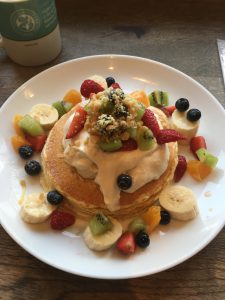
I’ve noticed that in Japan public transportation is a lot easier to understand, more on time, and cleaner. I think that this is mostly due to the characteristics of the people that live here. I’ve found that Japanese people are very precise and punctual. If I ask someone for directions or instructions, they are going to give me a very detailed explanation. Last week, Lincoln and I were trying to get back to the Sanuki Club and we were slightly lost, and a Japanese woman overheard and started trying to help us. We eventually found our way back, but it was just interesting that she was ready to jump right in with some directions. It also seems that everyone is very precise. My kickboxing classes always start right on time, and if I am doing something wrong, they are not afraid to tell me and correct me. I feel as if in the U.S. my teacher does not correct anyone because in the U.S. people would be more easily offended. However, here they do not hesitate to give you advice, which has actually been very helpful.
I’ve noticed in the subways that many people just sit quietly and look at their smart phones. Occasionally they will talk, but not often. One thing that I have noticed is that a lot of people do drink on the subway, but they do not eat. I have only seen two or three Japanese people eating on the subway, but I have seen multiple drinking water, soda from vending machines, Starbucks coffee, or tea. I have also seen a lot of people drinking while walking around. Never eating though. I think this is a large reason of why the subway stations and the streets of Japan are so neat! Subway stations are also very crowded, but this is similar to New York City in the US. I would say that the two subway systems are very different. Here, I haven’t seen too many homeless people on the subway, whereas, in New York there are many that will just sleep or perform on the subway for money. Also, in Japan, it charges you based on how far you go, whereas in NYC, one subway ride costs you $2.75 no matter if you’re going 1 stop or 10 stops. The subways in Japan are a lot cleaner and way more dependable. I have yet seen one to be late. I really love the transportation system in Tokyo!
Orientation Program Overview: Week Three
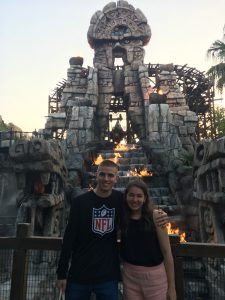
This week has been one of my favorites so far in Tokyo because I feel like I have become really good friends with my US fellows over the past few weeks and because we had a lot of free time to explore on our own. On Monday I went to Shibuya on my own and explored! And by that, I mean that I went shopping! I was hunting for some pants that I’ve seen a lot of Japanese women wearing. They’re high wasted with a stretchy waistband and they are flowy at the bottom. It took me a few stores, but I finally found them in Uniqlo! Uniqlo is a store that honestly has almost any basic clothing item that you would need. I could spend hours in there! After shopping, I went to dinner at an Italian place and had spaghetti with an egg on top! Oishikatta desu. Then, I went kickboxing and came back to do my Japanese homework.
On Wednesday, we had another free day, so Sam and I went to a Sake brewery to see how the sake in Japan is made. It’s actually a very long and detailed process. It was definitely interesting to see the history of it and see the suburbs of Tokyo. On Saturday, Lincoln and I went to Tokyo Disneyland Sea and we had a really great time! We rode a roller coaster and tried a lot of different popcorn. Apparently, they have six different flavors of popcorn and it’s a really big deal. We tried curry, milk chocolate, and garlic shrimp flavored popcorn. It was interesting to see that along with the children, most of the adults and teens were dressed up for the park. Everyone was wearing Disney gear!
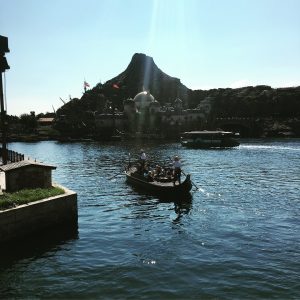
The Japanese culture talks were really great this week. My favorite one was by Kento Ito on the Spirit of Japan and the Kimono. I didn’t know anything about kimonos before this talk and now I feel like I understand the history behind them and why they’re important to Japanese culture. I like knowing the meaning behind the different types, and I think that Ito-Sensei’s project to spread the kimono around the world is amazing idea and it will be very cool to have people wearing them at the upcoming Olympics in Japan.
I have learned a lot of Japanese in the last few weeks; I’m pretty sure that I’ve learned a semester’s worth of Japanese in three weeks. I can ask simple questions in Japanese, give understandable answers, conjugate in 5 different tenses, describe objects, places, and people, and formulate sentences. I’m very proud of all of the progress that I have made, but I know that I have a long way to go. As I was preparing for my final speech, I realized that there were a lot of things that I didn’t really know how to say. There are still a lot of grammar structures that I need to learn, vocabulary that I need to memorize, and it feels as if there is an infinite number of kanji that I have to learn. I definitely want to continue learning Japanese and practice while I am at my host laboratory!
Introduction to Science Seminars
On Tuesday, we listened some really interesting talks about Carbon Nanotubes. My project isn’t about carbon nanotubes, but I do find their properties to very interesting. On Thursday, Professor Stanton finished his talk by discussing Terrahertz Spectroscopy, Semi-conductors, and Phonons. I learned a lot about phonons last summer while doing my research with superconductors, so this was a nice review.
I still have many questions about my research project because I haven’t received a lot of information on it yet. I want to know more about quantum software and how I am going to go about designing it. I have been doing some of my own research to see how a quantum computer works and what my lab has been working on. I’m very excited to start my research and I know that next week is going to be full of questions!
Question of the Week
Why do younger aged students have to wear uniforms to school?
- Because in Japan, they are cool! School uniforms in a sense, are an announcement of which group/school you belong to and a key part of forming group culture. Indeed, uniforms of all kinds in Japan are much, much more common than in the U.S. and it is thought that by putting on your school/work uniform it puts you in that mindset to learn/work. While they are at school, students typically have to wear their uniforms in the ‘proper’ way, once they leave school students may alter their uniform by changing out their shoes, rolling their skirt up, or adjusting their shirt to be more fashionable. School uniforms are just a key part of school culture in Japan and while students may not always love to wear them, they don’t have the same negative connotation that they do in the U.S. where school uniforms (at least in public schools) have historically not been common. This is another example of how being a member of a group (and showing that group affiliation through the uniform you wear) is valued more highly in Japan than the individualism that most American students value in being able to make their own fashion choices each day.
- For more see the following sections of our Life in Japan resources page
- ‘Elementary, Junior, and High School’ section under Education in Japan
- ‘Uniforms and Matching Outfits’ section under Fashion in Japan
Week 04: First Week at Research Lab
This week has been a blast in my research lab! I am honestly so happy to be where I am! When I arrived, Itoh-sensei (a Dean of the university and my professor) picked me up himself from the university station and we took a taxi to Yagami campus for a 9:00 AM weekly meeting. Every week, someone from the Itoh lab group gives a presentation about their current research. At the meeting, he introduced me to all of the students and everyone was so warm and friendly! Most of the students are actually undergraduate seniors, so not too much older than me. Also, almost everyone in the lab speaks great English. I’m still trying to speak in Japanese to them occasionally though. They laugh at my attempts and they think it’s great that I’m trying to learn. A lot of the people in my lab have studied in the U.S., mostly in California, so it’s been very easy to relate to them. After the meeting on the first day, Itoh-sensei introduced me to the rest of the lab and he gave me a giant book called Quantum Computation and Quantum Information. He told me to read the first six chapters, and currently, I am on chapter four. The material is really hard, but my lab group has been really helpful. Kento, a PhD student in my lab, is so nice and he spent about an hour trying to explain to me the meaning behind the eigenvalues and eigenvectors of quibits. He’s very smart and good at explaining! I’ve found that everyone here is so helpful and they will not rest until they have helped you. Kento took out multiple books and googled things so that he could understand and then explain it to me. After receiving my book, Itoh-sensei explained to me that my project was going to grow from what I learn from reading and playing around with the IBM software and that soon he would give me access to the 20 quibit quantum computer.
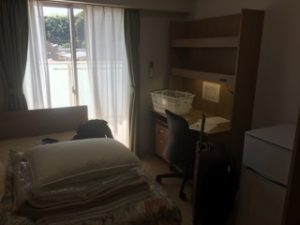
After, the entire lab had lunch together in the cafeteria. The food was really good and inexpensive! Apparently, the entire lab eats with Itoh-sensei every Monday because he is usually busy during the week, but he is always around on Monday for the group meeting in the morning. After this, Itoh-sensei had two undergraduate students help me to my dormitory. Tsubasa and Deiki helped me carry my suitcases and find my dormitory. They were so nice and helpful. Tsubasa speaks really good English and he and I have become pretty good friends over the past week. He even invited me to play tennis with him!
At my dormitory, an RA showed me around and to my room. I live in a suite that I share with three other girls, one non-Japanese and two Japanese. We each have our own private rooms with a balcony, closet, desk, bed, and mini fridge, but we all share a bathroom and living room with a TV. One thing that I noticed is that it’s really high tech. Our toilet has a motion sensor that allows the lid to open when someone walks into the bathroom. Also, everything is controlled by key card, which I like. Also, no shoes inside the dormitory. You must take them off at the door. I really like this because it keeps everything super clean. There’s a common kitchen area on each floor, which is really nice, but I haven’t really gotten a chance to cook yet.

I usually get to my lab at 9:00 AM, which is still early because nobody shows up until 10:00 AM, or sometimes 11:00 AM. And I usually don’t leave until about 8:00 – 9:00 PM. They don’t have strict rules on when I should come in or go, but I like staying later because I like hanging out with my lab mates and eating dinner with them. We got lunch and dinner together every day this week. Sometimes we go to the cafeteria for lunch and on Thursdays and Fridays, we eat at the food trucks on campus. They’re so delicious! I usually eat with Kento, Tsubasa, and Hiroki. Hiroki is really nice and he lived in Georgia for most of his life, so he actually has an American accent. For dinner, we either go to the 7-11 or we cook together! We made soba on Wednesday night! Apparently, the lab cooks a lot together. They made curry just the weekend before and they want to make more food with me this summer! They really love to eat, and I do too, so it works out nicely! Kento keeps mentioning all of these ramen and burger restaurants that we should go to together, and next Saturday we’re all going to Tsukiji Fish Market and Asakusa together. Kento planned the entire trip for us and I think there’s about ten of us going. I’m really looking forward to it! I also think that they’re throwing me a welcome party this week! I just feel so lucky to be here and to be doing research with such great people!
I like my housing a lot because I get my own room here and back in New Jersey, I share a room with two other girls. It’s nice to have my own privacy and the dormitory is completely new! Everything is so nice! The only thing is that I’ve found is that it’s hard to make friends in the dorm because most people already have established friend groups, and I’m never here. I usually come home from lab and then go to bed. Also, I still haven’t met two of my roommates. I met one of them on the first day and we bonded instantly! She seems really nice and I think we’re going to get lunch together next Sunday. However, I haven’t seen the other two. Tonight, one of them had their door open a little, so I knocked so that I could introduce myself, but then she got up and closed the door…. This is probably the saddest thing that has happened to me so far. I’m so thankful to have such a great lab, but it would be nice to have some friends outside of my lab as well.
Reflections on the Orientation Program in Tokyo
The orientation program definitely provided me with the skills necessary to feel comfortable and succeed in Japan. The language classes provided me with a lot of vocabulary so that even if I cannot speak fluent Japanese, I can ask for directions, ask someone to take a picture of me, and introduce myself. This has been helpful on numerous occasions. I also liked that the program got me comfortable with the area, so that now I feel at home here and I’m not afraid to explore on my own. My favorite things about the program though were the friends that I made. Our group has a snapchat group chat talks everyday, and I use line to communicate with the others from the program often. Lincoln and I message everyday and share our experiences. It’s nice having someone to share it with who is having similar experiences. I like that the program gave us three weeks to bond together and create inside jokes and memories. I’m glad that we didn’t just separate right when we got to Japan.
I think so far the things that I have learned in Japan are that:
- Everything is better with an egg on it.
- If you fall down seven times, get up eight (I definitely am learning this in my kickboxing classes).
- Don’t be afraid to ask for help with anything!
- Eat everything. It’s okay not to like something, but it’s not okay to not try it.
I look forward to learning much more this summer, and I am excited for what this week holds!
Research Project Introduction
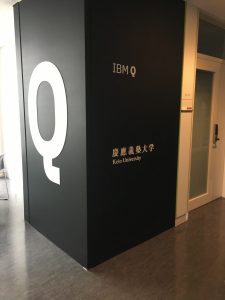
So, as for my research project, I’m still not entirely sure what it is yet. Itoh-sensei said that I would be designing quantum software using the 20 quibit quantum computer that only three other universities in the world have access to. I think that this is super interesting, but first I need to understand how single quibits work. Therefore, Itoh-sensei gave me a book on quantum computing to give me some background knowledge. I learned a lot of information this week about quantum circuits and how everything involves matrices. A linear algebra and a quantum mechanics class would have really helped for this project. It’s a good thing that my multivariable calculus professor went over how to solve for eigenvalues and eigenvectors of matrices at the end of the course, or I would be so much more lost. It’s interesting though because now I understand what the eigenvalues actually represent. I also learned about quantum teleportation and quantum entanglement in greater detail than what I learned in my Modern Physics course. I think the most useful thing that I learned is that almost all of quantum mechanics has to do with operators (which can be represented as matrices) on quantum systems. Qubits can be described like this with their operators being quantum gates. For examples, the single qubit gates are just the Pauli Matrices. I’m very interested in this type of research and I can’t wait to start actually using the quantum computer. I think I will find out more information on my actual project tomorrow when I see Itoh-sensei and talk with him about my progress. Thus, the goals of my project are not entirely clear as of right now. I do hope that they get cleared up soon. I also know that I am going to need a lot of instruction on this project because I have never done this before at all and everything is still so new to me in the quantum world. I am up for the challenge and excited to learn!
Question of the Week
Why is eating a meal together so important in Japanese culture?
- As a collectivist society, the identity of the group in Japan often takes precedence over the individual. This can be seen in the out of office/lab group activities and bonding that can be common in Japanese research groups. These types of group meals/activities tend to be much more common in Japan than in the U.S. where often each member of the group will come and go at different times throughout the day and/or eat lunch on their own or at their desk.
- You may also want to refer to the Geert-Hofstede handout we gave you during the Pre-Departure Orientation and, in particular, the section on Individualism (US) vs. Collectivism (Japan).
- The fundamental issue addressed by this dimension is the degree of interdependence a society maintains among its members. It has to do with whether people´s self-image is defined in terms of “I” or “We”. In Individualist societies people are supposed to look after themselves and their direct family only. In Collectivist societies people belong to ‘in groups’ that take care of them in exchange for loyalty.
- You may also want to refer to the Geert-Hofstede handout we gave you during the Pre-Departure Orientation and, in particular, the section on Individualism (US) vs. Collectivism (Japan).
- Also, it is important to keep in mind that in Japan most undergraduates stay at the same university for their graduate degree. Therefore, the lab you join as a B4 (senior) is likely the same lab you will be working in during your Master’s and even PhD program. Therefore, forming strong relationships with other group members is easier and becomes more important when you consider that you will likely be working with many of these people for three or more years.
- Group meals are also easier logistically in Japan as, typically, there is a set period of the day called ‘core hours’ where everyone in the lab is expected to be at the office/lab. Since most lab groups share one large office together rather than being spread across multiple offices or even buildings (as is common in the U.S.) it is also easier for the group to go out to lunch together as everyone is all in the same place and can leave and return together.
- However, how often the lab group does things together or what they do (lunches only vs. evening/weekend activities too) very much depends on the individual lab group culture and the members of the group at that time. Usually, there needs to be one or two outgoing people in the lab who will organize/suggest activities that can bring people together. It is important to keep in mind that research groups do change over time as members come and go. So, just because the lab group does a lot together outside of the lab one year doesn’t necessarily mean that will happen all the time as the individual group members have a huge influence on this aspect of group dynamics.
- Many U.S. alumni say that the group meals/outings are something they really enjoy about doing research in Japan and are things that they may want to incorporate into their research labs in the future when they return to the U.S.
Week 05: Cultural Analysis – Life in Japan
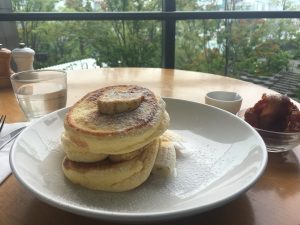
I’ve had a lot of interesting experiences being in Tokyo thus far, but I think one of my most memorable is going to be when I joined my kickboxing gym. So I found this gym using Google-sensei and went looking for it after only being in Japan a day. I love kickboxing so I was looking for a place that I could go to for the entire summer because I knew that Keio wasn’t going to be too far away. I arrived at this place and the first thing that I noticed was that it was much smaller than my gym at home and the second thing that I noticed is that, to be blunt, there was not a single person there who was not Japanese. Also, there were only males. This made me feel very timid about walking in and so I awkwardly stood outside for a few minutes, observing through the clear, glass window. The instructor saw me lurking and he came out to greet me. Of course, he didn’t speak any English, and I had only had a day of Japanese lessons. I introduced myself and then tried some form of Japanese-English (with a lot of pointing) to convey that I wanted to try a class. He invited one of his students over, who could thankfully translate for us, and we talked about class times/fees. He made a gesture for me to come in and I did without thinking, and I stepped on their dojo floor with my shoes. This is a BIG no-no in Japanese culture. And immediately when I did so, I had about six Japanese males say “no, no, no”. It didn’t take me long before I realized what I had done and I retreated back out the door and I apologized numerous times. I felt so embarrassed. They were so kind about it though and they just laughed at me because I was clearly a foreigner and didn’t know something so simple about their culture. They didn’t hold it against me, but in that moment, I felt like such an outsider.
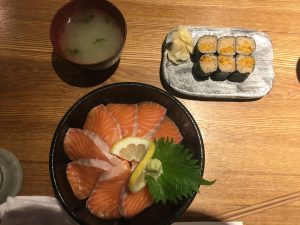
The sensei told me to come back for a class the next day, and I’ve been with them ever since. I’ve learned so much since being there! I’ve nearly perfected my left roundhouse kick, which makes me so proud! The gym here is a lot different than the one at home. The one here is more about community. Everyone helps each other out and everyone works together. In the US, I feel like my instructor is afraid to criticize me and tell me what I’m doing wrong, but here they call me out on my form and let me know how I can improve it. Also, here, we don’t just punch bags, but we fight the instructors. It’s so much fun to fight with my sensei, and I feel like he (along with the rest of the people at the gym) push me to work harder. I’ve even made friends there because the same people go everyday. A lot of them, including the sensei, know me by my first name! As soon as I walk in the door, my sensei yells “Hi, Kaitlin!” It’s funny because I will try to speak with them in Japanese and they will try to speak to me in English. It’s a nice balance. I’ve learned a lot from spending time there such as technique, endurance, community, and culture. To be honest, I don’t even think about it anymore that I am the only non-Japanese person there. They make me feel very included and all of them have been nothing but kind to me.
In the future, I will definitely think more about where I am entering and if I should take my shoes off before I do. I actually like not wearing shoes when I work out here. It’s going to weird when I go back to the US and I have to wear sneakers when kickboxing again.
Question of the Week
If hardly anybody in my kickboxing gym speaks English, then why do they play American/English pop music during the kickboxing classes?
Research Project Update
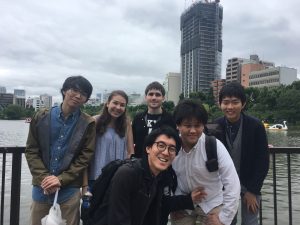
My research project is still in the learning phase. I’ve learned so much information in the past few weeks that I think my brain is on the verge of collapsing like a wavefunction when it is measured. I feel like I’ve learned the major details of Quantum Mechanics, Linear Algebra, and Quantum Computation/Information within two weeks. I definitely have a larger understanding of the subjects now than before I arrived, but I know that my understanding is not where I would like it to be. I find this topic to be extremely interesting, so I want to learn all that I can! I’m just struggling visualizing what the quantum system is actually doing. I think I have a good understanding of one qubit and what it does when we apply a Hadamard gate or one of the Pauli Matrices to it. I understand how we can represent it on the Bloch Sphere. However, when things start to get more complicated with multiple qubits, because we cannot represent the system on the Bloch Sphere anymore, I lose track of what is going on. Again, I understand what happens when I apply a Hadamard gate, but I am not sure about the other gates. Controlled gates really confuse me, and I understand the algorithms (Deutsch-Jozsa and Grovers) in theory, but I am not sure how to implement them on a composer. I had a session with Sekiguchi-sensei this past week and he tried to explain part of Grover’s algorithm, but I don’t think that I fully understood it because I didn’t know the right questions to ask. This week, I am going to prepare detailed questions ahead of time so that I can better understand it so that I can start using composer on my own.
I still don’t have a defined research project. I spoke with Itoh-sensei on Monday and he told me that I should spend the next few weeks learning on the 5 qubit system before I switch to the 20 qubit system after the mid-program meeting. He said that after I become familiar with the system, we would talk about a possible project that I can work on with one of the chemistry or financial groups here at the IBM Q hub. I’m honestly glad that a large component of my time with this project is going to be spent learning. I feel like, in the past, I’ve done research where I take measurements but I have no idea what is actually going on, or why the physics works. I feel like this is what most undergraduate research is like. I would rather know the fundamentals of what I am doing before I actually do it so that I can explain it and know that I understand it. So if by the end of the summer, I have a solid understanding of how quantum computation works and I get to implement something that showcases my knowledge, I will be thoroughly satisfied.
I am glad that I am working on this project now because I think I have found what I want to research in the future. Yesterday, I even enrolled in a Quantum Computation and Quantum Information graduate level class for this upcoming semester. I had to move a class that I was going to take to the spring semester, but I think that it’s going to be worth it. Also, I think it’s amazing the kinds of opportunities that this research brings. Every Tuesday, the IBM Q hub here gets together for a 2 hour seminar presentation, and this week, I met one of the professors from a different campus at Keio, who is working on quantum computational software and he was trying to convince me to come to graduate school at Keio! He even knows a professor (Dr. Dave Farber) here, who is the head of the Cyber Civilization Research Centre at Keio, who is a Stevens graduate and is still on the board of trustees for Stevens! We’re all getting dinner this upcoming Friday! Opportunities, they’re everywhere! So, that’s mainly where I am with my project. I hope that by the end of this week, I have an even better understanding of how to use quantum gates in the composer.
Week 06: Cultural Analysis – In the Lab & Preparation for Mid-Program Meeting
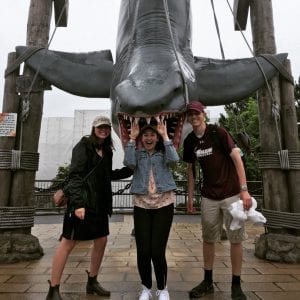
I definitely think that I won the lottery when it comes to my lab group. They are some of the most helpful and friendly people that I have met in my entire life. I’ve noticed that they have a strong sense of community that I don’t think labs at my university in the U.S. have. Here, they care about each other. It’s about the group rather than the individual, and I think that this is what American lab groups should be like as well. I didn’t know that it was going to be like this when I arrived, especially because I did research in Belgium last summer and everyone there was so focused on their individual projects that I didn’t get to interact with many of the members in the group. In Belgium, I ate lunch everyday while I did work in the lab, so naturally, on my second day here, I thought that I would be doing the same. Without telling anyone, I left my desk and went to 7-11 to get some lunch, and when I returned, I saw that my lab-mate Kento looked puzzled. He explained to me that we all usually eat lunch together as a group. I felt so embarrassed! I just assumed that everyone would be so focused on their research that they do their own thing. But no, everyday, the lab members pause their research, and we all go get lunch together. I absolutely love this because it gives me a break from my work and it’s fun getting to talk with all of the people in my lab. It allowed me to make friends faster. Since then, we’ve gone to lunch every day together, and eaten many dinners together too. We even cook together!
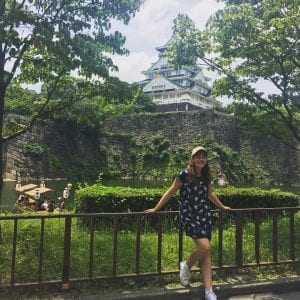
Last weekend, the whole lab took a trip to Tsukiji Market in the morning for fresh sushi and then spent the day walking around Tokyo and eating. We walked 20 kilometers! My lab group is absolutely amazing, and they’re also very helpful when I have questions about my research. Kento is so unbelievably smart and he will spend hours explaining concepts to me. I feel bad for taking up his time, but even when I tell him that it’s okay and I’ll learn it myself, he insists on helping me until I understand it. Everyone here is very patient with me, whereas I feel like mentors in America grow impatient very quickly with teaching someone new in the lab. Everyone here also treats me with an enormous amount of respect, even though I am the youngest. The lab here feels like home, and I am going to be very sad when I have to leave. I would honestly love to come back and work here again, for graduate school, or after I get my PhD. The environment here is truly one of a kind.
Outside of research, I think I am most proud of myself for learning to spend time with myself and for nearly perfecting my left roundhouse kick! I am a very social person, and I love hanging out with my friends back in the US. I’ve never lived in an environment where I had so much time to spend alone. I go out with my lab-mates, but I don’t have too many friends in my dormitory. So, what do I do if there’s something that I want to do and I have no one to go with me? I do it anyway! I want to experience all that I can in Tokyo, including all of the themed cafes, shopping districts, and outdoor activities. So, if there is somewhere that I want to go, I have learned that it is still fun to go by myself. I think it’s important to be content with being alone as well as spending time with friends. I’m proud of myself for being able to go into a restaurant alone and still enjoy my meal and have a cool experience. Also, I have nearly perfected my left roundhouse kick that I never thought I would be able to do. I have always kicked better with my right leg. It’s really hard for me on my left side, but my kickboxing sensei taught me how to swing my body so that I can strike the bag powerfully. It’s so much fun to do!
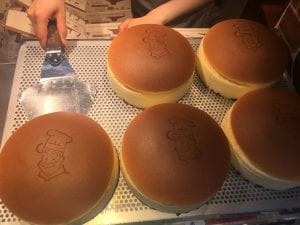
I think that my biggest personal challenge so far has been making friends. I’m starting to meet more people now, but the first few weeks were rough. The language and culture barrier is a real thing, and it’s harder than it was in Belgium or any other country that I’ve ever been. Things are definitely looking up though as I am being introduced to more undergraduates around campus. I think it just takes time.
As far as research goes, I am very proud of what I have learned so far, and I finally have a project! I think that the timeline is going well as I have enjoyed learning all that I have, and I’m glad that I have a decent idea of what quantum computing is, how it works, and how it is going to impact us in the future.
Research Project Update
I’m thrilled with my research progression this week. I feel like I have learned a lot about Quantum Finite Automata, which is a project that I was assigned after the IBM Q group meeting on Tuesday! Dr. Rudy assigned me the task of drafting a Qiskit tutorial page for a quantum algorithm that was written in 1998. We have the algorithm, but he wants me to find a way to code it in python so that we can implement it with a quantum computer. I think that I am going to have a few projects this summer with IBM Q department rather than just one, but we’ll see how long it takes me to finish the first one.
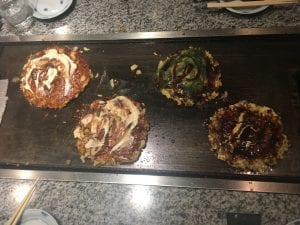
I’ve already come up with some code, and I think that it should work in the composer, but we’ll see. It might work in the quantum similar, but there could be a lot of noise with the real quantum computer, so I might have to tweak it. So, this project could end up taking me a while, but I feel like I am learning a lot and gaining more coding experience. I’m literally coding a quantum algorithm; I think it’s so neat! Also, when I finish the page, it’ll be published as a Qiskit tutorial page and I’ll be listed as a contributor!
The code isn’t very difficult, as the algorithm doesn’t involve the qubits being entangled. It’s mostly about rotations and getting multiple qubits to be in a superposition of states. I’ve learned a lot this week about Finite Automata, which I didn’t know anything about before. So, I am very satisfied with how my research is coming along. I hope that next week, I get a lot done with the page, so that maybe I can even have the code written by the mid-program meeting. IBM Q has other projects for me to work on after I finish this one, so it’s possible that I could have multiple tasks this summer, rather than just one big project.
Question of the Week
Why don’t high schools in Japan have prom or other school dances?
- Keep in mind that, while in high school, Japanese students must study very long hours for the college admission/entrance exams. In Japan, unlike in the U.S., admission to university is almost solely based on the score for your entrance exams so many students will go to after-hours ‘cram’ schools where they will specifically study for the entrance exam. Due to this, high school students don’t have as much ‘free’ time as many American high school students have (or at least as movies about high school in the U.S. make it seem) and parents may not want to actively encourage dating and events like school dances as it could take their child’s focus away from studying for the entrance exam.
- For more on high school life in Japan, see the Education in Japan section.
Week 07 – 08: Overview of Mid-Program Meeting & Research Host Lab Visit
Introduction to Research Presentation
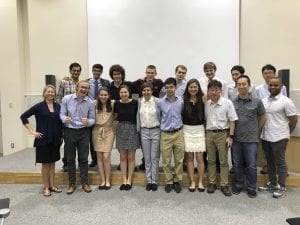
I think that the mid-program meeting was a great experience and that it nice to get to talk with other people outside of my lab about my research project. The truth is that I am just so excited about it! I’ve learned that quantum computing is something that I want to pursue in the future and I want to absorb all of the knowledge this summer that I can. I really liked presenting on my project, but I didn’t like that I only had five minutes. Since my project is more theoretical, it’s extremely hard to explain it in a few minutes. I think during my presentation, I talked too fast because I was nervous, and I didn’t give enough motivation for my project. I think by introducing more applications for quantum computing, it would have tied the project together more clearly. I also know that it’s a good idea to have extra slides (thanks Sahil!). It was nice getting to see all of the other fellow’s presentations as well because everyone seems so passionate about his or her work! I think that everyone is learning a lot in this program and I happy to see everyone’s hard work paying off! It’s also nice because we’re learning from each other. I think that overall, the mid-program meeting was a success and I look forward to presenting again at the end of the summer!
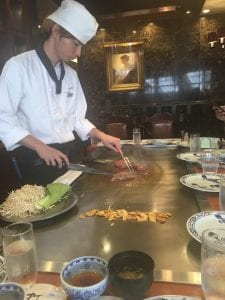
As for lab updates, right before the mid-program meeting, my mentor and I started officially working on a quantum speed-up algorithm for Quantum Finite Automata (QFA). I implemented my first bit of code for it the Friday before the mid-program meeting, and it works! There are just some kinks that need to be worked out before it is completely successful and ready to be put on the qiskit tutorial site. I’m excited to see what the next four weeks holds. I still have to finish this algorithm, finish drafting my tutorial page, and then start a project that was given to me by another mentor on creating diagrams for the different state vectors after each quantum gate has been applied in a circuit. This is going to be tough, but interesting as it is going to allow me to get more familiar with the different kinds of gates. This can get very tricky with multiple qubits and controlled-NOT unitary gates. I will begin this project sometime this week and probably work on both projects simultaneously! I hope that I can finish both of them in the next four weeks.
Reflections on the Mid-Program Meeting
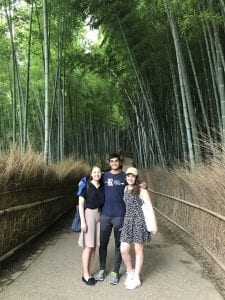
I think that the Mid-Program Meeting was very well timed due to the fact that I think many of us were just starting to feel lonely right as the meeting rolled around. Living in Tokyo is a blast, but sometimes there’s just no one to do things with. I am a very independent person, and I like doing things by myself, but I do miss having the other US fellows around. Therefore, it was nice to catch up with everyone! Spending time with them and the Japanese fellows was a blast! We went to Karaoke on the first night in Kyoto and had such a fun time! Over the course of the four days in Kyoto, I got to see a lot of the city and experience a different side of Japan. I went to the Bamboo Forest in Arashiyama with Hana and Sahil, and this is one of my favorite things that I’ve done so far in Japan! It was so scenic walking through the forest in the evening. We walked along the river and laid down on rocks that were right in the middle of the river, so that we had water flowing on both sides of us. It was a very peaceful night, and after living in Tokyo for two months, I really needed peaceful.
Kyoto culture is very different than Tokyo culture, and I absolutely love it. I enjoyed visiting the temples and shrines, and getting to dress up for a traditional tea ceremony. It was beautiful to see how intricate the ceremony was. I also really enjoyed hiking Fushimi Inari and seeing all of the Toriis. There is so much to do in Kyoto and a big challenge was trying to fit it all in. I do think that I got to see everything that I wanted to see. I also got to try Kobe beef in Kobe and it was the best beef that I’ve ever had in my life! It just melts in your mouth!
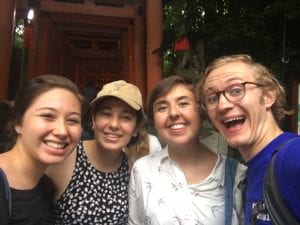
I think that during this week, I learned that there is still so much more that I want to do in Japan and I am running out of time. When we all had our long discussion after arriving, I realized just how much I still wanted to accomplish and that I only have four weeks left that are going to go by fast! I still haven’t been to an Onsen! So before I leave, I have a few key things that I want to do and try, and I want to complete my projects in the lab. I think I need to take more advantage of my surroundings in the next four weeks because after that, I won’t have the opportunity anymore, as I’ll be back in the US. I think this meeting really opened my eyes to the time crunch and I am now determined to do it all!
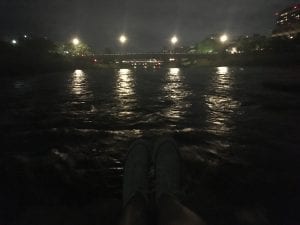
Question of the Week
Do Japanese companies sponsor Toriis at Fushimi Inari and get their business names written on them? I thought I saw this a few time. Does this bother the locals?
- While a bit morbid to start, this article actually gives a pretty good overview of how shrines are funded which might help answer your question. Since shrines don’t charge admission fees like most temples do (have you noticed that) shrines may be more likely to seek other sources of fundraising to raise funds for maintenance and other projects. For example, sake companies will donate the large barrels of sake you see outside of many shrines each year.
- You may also want to read about the Seven Lucky Gods in Japan, particularly Ebisu who is the god of prosperity and wealth in business.
Week 09: Research in Japan vs. Research in the U.S.
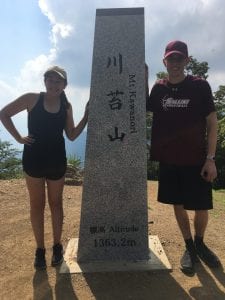
I haven’t actually performed research in the U.S. yet, but I do have friends that are doing research at their universities in the U.S., and from what I hear, the environment in the lab there is very different from my lab here. For starters, my lab here is very community based. From what I’ve heard from my friends in America, their labs don’t interact with each other outside of the lab and they barely interact with each other in the lab. It’s not often that they go to lunch together or help each other with their projects. Everyone is constantly working on their own individual needs.
I’ve found my lab here in Japan to be much different. Everyone stops working when it’s lunchtime and we all eat together. Sometimes lunch can last for up to two hours if we’re busy chatting. We also do a lot of activities outside of the lab together. We walked around Tokyo one day and ate a bunch of food. In two weeks, we’re going peach picking together. And on most Friday nights, we all cook food together in the lab and have a mini party. Everyone in my lab is pretty close with each other and we can ask each other for help if we need it. I’ve been asked to proofread English PowerPoints and reports, and there have been many times where I’ve asked my lab mates to explain a concept to me. Everyone is very friendly and eager to help if you have a problem. I think this is because Japanese culture is very different from U.S. culture in valuing community rather than the individual. I like this a lot better as it makes for a more fun, comforting, and productive work environment.
Sometimes in the U.S., because everyone is so busy working on their own projects, I feel afraid to ask questions because I don’t want to bother anyone. Here, I don’t feel embarrassed to ask questions at all if I don’t know something; I know that there will always be someone who wants to answer my questions.
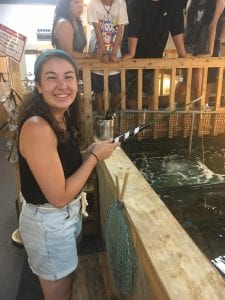
Working in Itoh Lab and the IBM Q Hub has been an amazing experience! I cannot believe that I have had the privilege to work under and with some extremely successful and intelligent people. I’m not sure if this is what I was expecting before I came to Keio. My only other research experience was last summer when I went to Leuven, Belgium to do experimental research with superconductors, and it was a lot different. Everyone there was working on his or her own project and there wasn’t a lot of social interaction, so I assumed there wouldn’t be here as well. Also, I assumed that I would be treated more as a young intern rather than as part of the team, but it’s actually been quite the opposite. They treat me as if I’m a valued member of the research group and they expect a lot out of me. This has been great though because it has pushed me to work harder!
Research Project Update
It was a little hard to get ahead this week as both of my mentors that assigned me projects were at conferences in other countries. Thus, I’ve spent my time trying to create test cases for my code and doing more research for Rodney’s project in creating visualizations for the output state vector after a quantum gate has been applied to a qubit. This is quite difficult as I’m not sure if this is even possible. I have a lot of questions for both of my mentors, but I am waiting until they get back from their conferences next week in order to go over my progress with them in person. Overall, I do believe that I will have my main project on QFA (Quantum Finite Automata) finished by the end of the program, which I am very excited for! This is the project that I have been writing a lot of code for; the other project is still in the research stage. I hope to get a good start on that project before I leave as well.
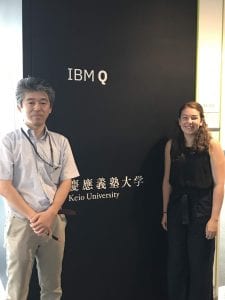
Host Lab Visit
This week, Sarah and Ogawa-san came to visit my lab! It was a lot of fun getting to talk to them about my project and my passion for quantum computing. Sekiguchi-San, one of my mentors, met with us and gave us a quick overview and tour of the quantum-computing hub at Keio. It honestly felt good to chat with someone about my project that didn’t already know about it. It gets me very excited and talking about it confirms that I actually understand what I am learning, which gives me more confidence!
Question of the Week
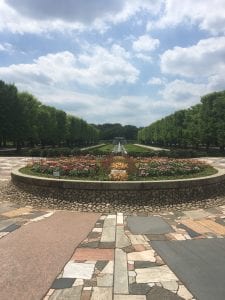
Is Onsen a more popular activity for girls or guys? I was talking to some people in my dormitory about this and it was hard to come to a conclusion.
- You may need to change how you are asking this question slightly. Onsen are natural hot springs that aren’t very common in the Tokyo area. You have travel outside of the Tokyo area to places like Nikko to actually go to an onsen (natural hot spring). So, a couple, friends, or family may take a short weekend vacation to an onsen retreat but these can sometimes be a bit expensive.
- However, taking a long, hot bath each night is very common in Japan. In the past, each neighborhoodin Japan had a local sento (or public bath) that people would go to regularly. This was because it took a lot of fuel (money) to heat up enough hot water for a deep/soaking bath and many older style homes may not have had the room/space for their own large bath. So, going to the local sento was historically a big part of Japanese society/culture that everyone did.
- Today, many sentos are actually closing/dying out since fewer people use them as most people now have deep, often highly advanced, soaking tubs at home. There actually used to be a sento in Azabu-juban that has now closed though there is still an ‘hidden’ onsen in Azabu-juban that most people don’t even know about.
- So, if you ask people if they ‘like to go to onsen’ they may think, yes, but I don’t get to do it often since it is a special trip outside of Tokyo. But, if you ask them, do you take a long, hot bath in a deep tub regularly – the answer is probably yes as this is often part of their daily/regular routine in Japan.
Week 10: Reflections on Japanese Language Learning
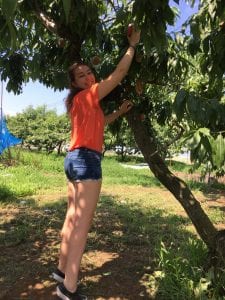
I think that in the last few months, my vocabulary has improved a lot, but not so much my grammar in Japanese. I’ve been learning a lot of new words from my lab-mates and just by listening around me. If people are having a conversation in Japanese, I can usually pick up what they’re not talking about, but I could definitely not translate what they’re saying. I think that I’ve had multiple experiences in Japan where not knowing the language has been a problem. Such times are usually when I’m using transportation and I’m lost and someone is trying to explain directions to me and they don’t speak English. Usually in those situations, I just thank them and then try to figure it out on my own. Fortunately, most people around me do speak pretty fluent English. My lab-mates talk to me in English easily, and my friend Yuca, who has become a really close friend of mine over the last few months, speaks perfect English because she lived in the U.S. during her middle school years. Thus, I don’t have to speak Japanese to communicate and connect with a lot of the people here. It is fun to learn new phrases and I enjoy it when I ask my lab-mates how to say things. I would love to continue learning Japanese, but I don’t think that I am going to have many opportunities to. My university at home does not offer Japanese, so it would need to be a self study project that I’m not sure I have the time to take on when I return back home. I will always be open to learning new phrases and I will definitely be taking a lot of them with me back to the US. I think for a while, I am going to be saying “sumimasen” and “arigato gozaimasu” for a while. And if I ever come back to Japan, I look forward to picking up even more of the language.
Research Project Update
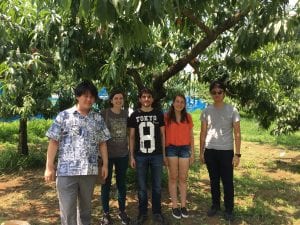
This past week was a little rough for my project. I felt like I was stuck and I wasn’t sure about a lot of my code. I stared at it for hours and tried to understand my own work and rework through the algorithm. About midway through last week, I was getting pretty down on myself because I wasn’t sure if I was going to be able to understand it or finish in time. However, things turned around completely on Friday. I saw my mentor and we worked through it together and it cleared a lot of things up! I think I even surprised him with how much I understood it. I know that I surprised myself. Now I think that I am on track to finish my code and my tutorial page this week, so that I can spend next week working on the poster. I am very happy with how much I have learned this summer and I am so glad that I have made the connections that I have made. I feel so lucky to be working with some of the most knowledgeable people about quantum computing! My mentors have been a lot of help and I hope that I even get to work with them again in the future.
Question of the Week
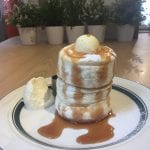
How big of a deal is surfing in Japan? Every time I go to the beach, I always see a ton of surfers.
- For more on this, see the Watersports tab under the ‘Sports in Japan’ section on the Life in Japan page. Also, fun fact, the 2020 Tokyo Olympics will be the first time that surfing is an Olympic sport!
Week 11: Interview with Japanese Researcher
Interview One – Kento Sasaki
I decided to interview Kento because he is one of the most influential people that I have met in my lab. He is extremely accomplished for being so young, and has been a very good friend to me over the past few months. Kento is a PhD student in the Itoh lab group at Keio University. He did his undergraduate and graduate level study at Keio University and has always been with the Itoh lab group. His degrees are in Applied Physics and he has been with the Itoh lab group for 4 ½ years now.
With only 1 ½ years left until his PhD, Kento is a thriving physics student. He has published two papers as first author, and according to him, too many papers to count as a second author. I asked him about his long-term goals, and his only real goal is to continue doing research at a university even past his PhD. I can tell from his enthusiasm and hard work that he puts into the lab everyday that research is really what he loves. He’s very helpful with other people’s projects and I think that he is going to make a great mentor/advisor one day if that’s what he chooses to do. He’s definitely helped me a lot in my time here, and he isn’t even a part of the IBM Q Hub!
Kento has always lived in Japan, but has traveled to a few other countries. He has been to Canada, Switzerland, and plans to go to Croatia. These have all been for physics conferences, so he has not had much time to explore around in these parts of the world. He has never been to the U.S., but he’d like to. After finishing his PhD at Keio, he stated that he would be open to doing research in another country for the short term, but Japan is definitely his home.
I also asked Kento what made him want to study physics, and his response was, “I like physics because it shows us how we can control the environment around us.” Kento has been a role model for me throughout my time here, as I always see that he is hard at work. Sometimes he doesn’t leave the lab until very late at night or early in the morning. It’s nice to have lab-mates with such dedication that make me strive to work harder. I’m thankful for getting to meet Kento and all of the other Japanese research students in my lab!
Interview Two – Professor Noaki Yamamoto
I decided to interview Professor Yamamoto because he is one of the leaders of the IBM Q Hub and has a wide variety of knowledge from quantum computing to information theory. He received his Bachelors degree from Tokyo University, and at first, had trouble deciding what he really wanted to study. He switched from brain science to control theory with engines and systems to information theory and then finally to material science in 2001. From there, he discovered the idea of quantum teleportation and this idea fascinated him so much that he switched again to quantum.
For his 3 year PhD track, he combined control theory with quantum. However, he believes that his greatest growth and learning experience was done when he was a post-doc at Cal Tech. One of his mentors, Luke, changed his life and really inspired him. Thus, his son’s middle name is Luke. After Cal-Tech, he spent some time in Australia, and joined the engineering department there, before getting an offer for a position at Keio University. He has now been at Keio the last 10 years and is currently working on improving the IBM Q hub.
His advice for students who want to follow a path in quantum computing is to learn the Qiskit tutorials and study a lot using the IBM resources online. When asked if he believes that there are cultural differences between research in the US and research in Japan, he stated that he believes so. He believes that in the US, you may be able to get closer with your professors because you can sometimes call them by the first name, whereas this is completely unseen in Japan. He definitely enjoyed his time in the US, and is excited for future young researchers to experience what he experienced.
Reflection on the Interviews
I really enjoyed getting to talk with Kento and Professor Yamamoto openly and ask them about their accomplishments. I know that there is a lot that I can learn from both individuals. Kento and I have been friends since my first day here at Keio, and so I felt very comfortable asking him questions. However, my interview with Professor Yamamoto was also the first time I got to officially meet him, and so I was a bit more nervous. He is so kind and open though that I felt comfortable right away. We started talking about his children, and I told him that my older sister is expecting soon and that I bought her a series of books called “Physics for Babies”. They’re so adorable, and they have them for a wide range of topics. I showed him how he could order them on amazon for his children and he was surprised when he saw the author’s name. Apparently, the author Chris Ferrie, is one of his good friends and they co-author each other on a lot of papers. Chris Ferrie is a professor for one of the quantum computing departments in Australia! I thought that this was so neat how most physicists know each other! I feel like I have made so many connections this summer and I am thankful to all of the brilliant and wonderful mentors that I got to interview and work with!
Question of the Week
How hard are final exams in Japan compared to the US?
- The key difference here is what your grade is based on. In the U.S. your final grade may be based on a number of assignments over the course of the semester, your participation in class, and the final exam/report. However, in Japan, it is more common that the majority of your grade is based on your final exam scores alone. This is actually quite common in many educational systems around the world, including many countries in Europe, and is one reason that American students sometimes struggle when they take classes abroad as we are not as accustomed to such ‘high-stakes’ testing for final exams and course grades. In comparison, many international students who study in the U.S. may be surprised that participation in class comprises part of your final course grade. So even if you score perfectly on the final example, you may still end up with an A- or a B if you did not participate in class. You might want to talk more with some of the Japanese Fellows or your friends in Japan about how they receive grades for their university coursework in Japan.
Research Project Update
Well, my research project is really at an end! I finished my code and it works perfectly on the simulator. I worked with my mentor at the end of last week to try it on the real quantum computer, but there is a lot of noise, so it doesn’t work all of the time. My mentor and I are going over tomorrow how we can minimize that noise using error correction techniques, but I’m not sure if that part is going to be finished before I leave. It might be a future project for someone else instead and I can include it on my poster as future work. I’ve been working on my poster and getting suggestions from my mentors, so hopefully that is done soon as well. All in all, this has been a great learning experience and I am excited to wrap up my project this week!!
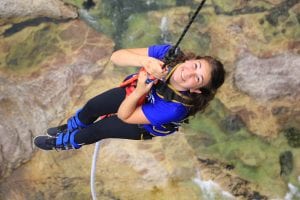
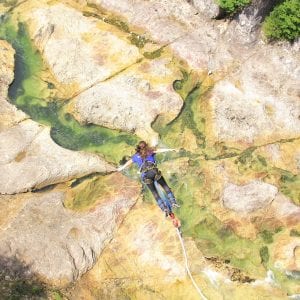
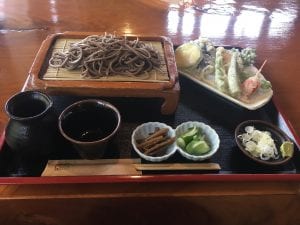
Week 12 & 13: Final Week in Japan & Re-Entry Program
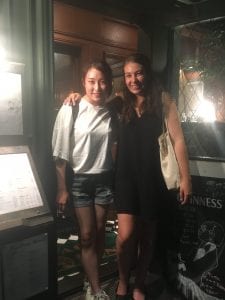
My final week in Japan was crazy. There was so much to accomplish with my project, poster, and everyday life. My project was done by Tuesday, so I got to spend the rest of the week focusing on my poster, talking with my mentors about graduate school, and saying goodbye to my lab mates and friends. I am so thrilled that I got to work with Raymond and Rodney this summer. They were truly amazing and taught me a lot. I think that I developed really strong ties with them that I’d like to keep in the future. Rodney told me that he would be thrilled to take me on as a PhD student at Keio, which literally made my life. It was such an honor to have someone as successful as him tell me that he would be delighted to work with me. I was over the moon, and I think that he would be an amazing advisor.
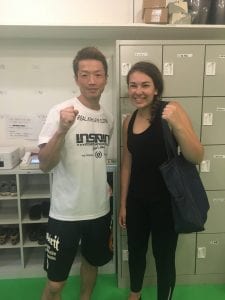
I’m definitely considering coming back to Keio University for graduate school. It was very sad to say goodbye to my mentors, my lab-mates, and my friends. My friend Yuka and I had gotten really close this summer, and the night before I left, I went over to her apartment and we made dumplings and pumpkin pie. She’s such an amazing person and I know that I am going to see her again. It’s just sad that she and the other people that I grew to love are so far. That’s the best and the worst thing about traveling abroad: meeting awesome people. My lab and I went to a jazz bar for my farewell party and we had a blast. It’s crazy how much time I spent with them this summer and how much it saddened me to say goodbye.
Re-Entry Program at Rice University
I guess all good things must come to an end, at least until the next adventure. Coming back to Rice in Houston felt weird. Getting off the plane felt wrong. I didn’t see Kanji anywhere, people weren’t dressed as nicely, and everyone could understand my English again. I didn’t like it and I immediately missed Japan. I am happy to be home and seeing my friends and family after all this time is a good feeling, but I feel like I left a part of me in Japan. I feel like that’s true wherever I go. It’s like I’m leaving horcruxes (Harry Potter reference), or pieces of my soul, in all of the countries that I live in. First in Belgium, and now in Japan. It’s because of this that I know that I will go back to visit.
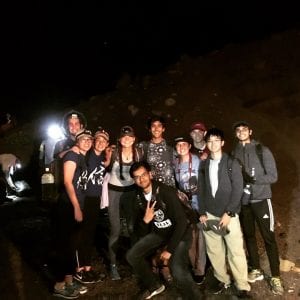
I definitely enjoyed the re-entry program and getting to spend time with my Nakatani fellows one last time. I am really going to miss them. We became very close this summer. They felt like family, and I still think of them as such. I am sure that we will meet up in the future. It’s inevitable. They’re all so bright and I am so proud to know them. I can’t wait to see what great things they do in life.
I think my only perception of Japan that has really changed is that it doesn’t seem so out of reach anymore. I used to think of Japan as this unknown country that would always be out of my reach to explore. Now, I realize that it’s actually not far. Nothing is actually far. My perspective of the world has changed; I don’t believe that it is so small anymore. This summer changed me. It made me realize that I can have friends and connections all over the world and that I shouldn’t be afraid to care about people that I can’t see everyday. All that matters is that I will see them again and this summer convinced me that I will. There will always be an opportunity because I will look for those opportunities. Living on my own this summer also changed me. Now I have to go back to school and live with two other roommates in one bedroom. This is going to be harder now I think as I am used to having my own space. But it did allow me to appreciate my roommates more when I was lonely in Japan. I realized that I need a balance.
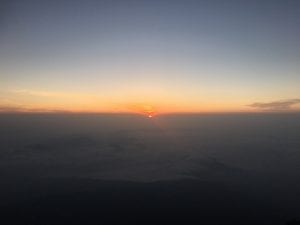
The Nakatani research program definitely impacted my academic life as now I think I am many steps closer to knowing what I want to pursue. I really want to get my PhD in quantum computing and I would have never known that if it weren’t for this program. I would and I will recommend this program to anyone and everyone. I want other students to have this opportunity. It truly is a once in a lifetime one. I can’t wait to share my research with my professors and my experience with other students. I am definitely going to encourage freshman and sophomores at my school to apply.
Final Question of the Week
What is the best time of year to visit Japan?
- Best Times to Visit Japan (Travel+Leisure)
- When Not to Visit Japan and When to Go Instead (Live Japan)
Final Research Overview and Poster
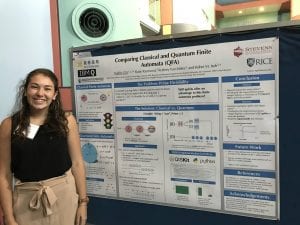
I am really proud of the research that I did this summer and my presentation. Presenting at the poster session was a lot of fun! It was my first time to do a poster presentation, so I’m also just really happy to have had the experience. Now I know more for my next poster session, and I am sure that this is just the first of many. The final oral presentation in Tokyo was also a good experience. It’s nice to be able to share my research with others and answer questions.
Research Project Title: Comparing Classical and Quantum Finite Automata (PDF)
Host Lab in Japan: Keio University – Dept. of Applied Physics & Physico-Informatics, Itoh Laboratory and IBM Q Hub at Keio University
Host Professors: Professor Kohei Itoh, Dr. Rudy Raymond, Dr. Rodney Van Meter
Introduction: My research topic was in quantum computing and creating a quantum algorithm for finite automata. My specific finite automata problem was if we have a string with a certain length, is the length of the string divisible by a given prime number? Obviously, we can solve this classically, but I wanted to see what would happen if we were to use qubits instead of bits.
Big Picture: This is important for two reasons: the first is that it demonstrates the power of quantum computers and the need for further exploration of quantum algorithms and the second is that we can apply quantum finite automata to real world applications such as quantum elevators or traffic lights.
Approach: I took a look at the classical algorithm and thought about how we can use qubits to our advantage. I created an algorithm that would provide a quantum advantage and coded it using python to see if it would work. Then I tested it on the local simulator and the real quantum computer.
Results: My results were that the algorithm with qubits requires exponentially less memory. We can use loglog(prime) qubits instead of log(prime) bits.
Discussion: This result is important because we now know that we can optimize finite automata with a quantum computer. This is just another of the many possible applications for quantum computers in the future.
Future Research: The next steps in my research project would be to test the algorithm on larger quantum computers with more qubits and find ways to filter out the noise.
Follow-on Project
I am very excited to introduce the Nakatani program to more students, as I believe it to be the best opportunity out there for undergraduates. I am going to do two different things for my follow up project. The first is that I am going to make a powerpoint for my Girls Who Code group at the local Hoboken Charter School. All of my girls know that I got this program and they screamed for me when I told them. I am so excited to see them again and share my experience. I want to excite them and show them the opportunities that come with studying a STEM field. I plan to show them some of the fun sides of traveling in Japan and also a basic overview of my quantum computing research because it ties to the theme of our group. I am also going to present this program as a study abroad opportunity at my school. I am a global ambassador for my school, which means that I encourage students to study aboard and run study abroad fairs. I will present about the Nakatani program at multiple fairs and give multiple presentations to the honors students at my college. I want to make sure everyone knows how amazing this program is.
Tips for Future Participants
Pre Departure Tips
- Study more Japanese vocabulary and phrases
- If you’re a girl, pack as many casual dresses as possible because it’s hot and not many people wear shorts in Japan
- Don’t over pack! 3 Pairs of shoes max and don’t bring too many clothes; you will buy some there.
- Bring many thank you notes ahead of time because they can be expensive in Japan and you will need a lot for multiple occasions.
- Research possible things that you want to do in Japan before going
Preparing for Research Abroad:
- Don’t stress about not knowing anything about your research topic beforehand. You will learn a lot in the first few weeks that you’re there
- Focus on finishing up your semester strong and then think about your research. There is no use doing poorly on your finals. Your research can wait.
Orientation Program Tips
- Try not to fall asleep in language class
- Take advantage of your time in Tokyo if you’re not staying there for the research internship period and take advantage of you time with the other Nakatani fellows… you may feel slightly more lonely when you get to lab.
- Explore grocery stores! Don’t just go to 7-11.
Mid-Program Meeting Tips
- Again, spend time with the other Nakatani fellows while you can
- Spend time with the Japanese fellows!!
- Don’t over pack! You’re only there a few days.
- Try Kobe beef in Kobe! Yum!
- Visit Fushimi Inari and the Bamboo Forest
- Don’t stress about your presentation! You don’t need to have results by then or even a set project!
Working With your Research Lab Tips
- Try to eat lunch and do things with your lab
- If your lab invites you somewhere, go! It’ll be fun!
- It is okay to leave lab if you’re not feeling well or you need to take care of yourself. Don’t feel bad leaving.
- If you need a break during the day or need to take a walk, do it! Sitting down for 12 hours can make you feel gross and unproductive sometimes.
- Bring your lab members something back when you travel away for a weekend. It doesn’t have to be all of the time; but they will really appreciate it.
- Give your lab mates gifts when you arrive at the lab on your first day and when you leave your lab on the last day.
- Be open; it will make them open up more.
Living in your Research Host City – Tokyo
- Use the Tokyo metro! It is an amazing transportation system!
- Eat at the crazy cafes like the Kowaii Monster Café or the Lockup
- Shop in Shibuya!
- Get out of Tokyo and take an hour subway to Kamakura and Enoshima
- Take a sushi cooking class
- Go to Tokyo Disney Sea!!!
- Eat fresh sushi at Tsukiji Market in the morning (go early)
- Tokyo Tower and Tokyo SkyTree
- Visit Harajuku
- Eat ALL of the pancakes
Language Study Tips:
- Study vocabulary and phrases before coming to Japan
- Practice while you’re in Japan and review your notes before going to bed
- Keep up with your Japanese at your host university by taking a class or asking students to talk with you in Japanese. It’s really easy to lose your language skills as time goes on from speaking only English with your lab mates.
What Gifts to Bring:
- Pecan cookies
- Ghirardelli Chocolate Squares
- Pencils or postcards from your school
- Thank you and greeting cards
What to Eat:
- Try everything!
- Kobe Beef (in Kobe)
- Inari Sushi (in Inari)
- Sushi from Tsukiji Market
- Okonomiaki in Osaka
- Fluffy Cheesecake in Osaka
- Premium Pancakes from Café Gram
- Yakitori from an Izakaya
- Cheese Ramen
- Japanese Curry
- Sweet Potato Soft Serve
- Anything from a bakery
- Red Bean dessert
- Matcha anything
- Udon
- Soba!!!
What to Buy in Japan:
- Food
- Clothes and shoes in Tokyo
- Umbrellas!!
- Fortunes at a temple
- Gifts for people back home
What to do in Japan/Places to See:
- Bungee Jump
- Surf
- Tokyo Disney Sea
- Universal Studios Japan in Osaka
- Visit Osaka Castle
- Visit Minakami (you won’t be disappointed! Great for adventure sports and hiking)
- Hike Mount Fuji
- Hike Mount Kawanori
- Go fruit picking
- Eat/drink at an Izakaya
- Visit Kamakura and Enoshima
- Go to crazy themed cafes
- Karaoke!!!

